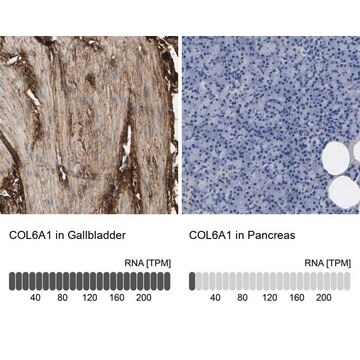MAB3303
Anti-Collagen Type VI Antibody, clone VI-26
clone VI-26, Chemicon®, from mouse
Synonim(y):
Anti-OPLL, Anty-BTHLM1, Anty-UCHMD1
Wybierz wielkość
2040,00 zł
Przewidywany termin wysyłki24 kwietnia 2025Szczegóły
Wybierz wielkość
About This Item
2040,00 zł
Przewidywany termin wysyłki24 kwietnia 2025Szczegóły
Polecane produkty
pochodzenie biologiczne
mouse
Poziom jakości
forma przeciwciała
purified immunoglobulin
rodzaj przeciwciała
primary antibodies
klon
VI-26, monoclonal
reaktywność gatunkowa
human, rabbit
spodziewany brak reakcji z
rat
producent / nazwa handlowa
Chemicon®
dostępność
not available in Japan
metody
ELISA: suitable
immunohistochemistry: suitable (paraffin)
izotyp
IgG1κ
numer dostępu NCBI
numer dostępu UniProt
Warunki transportu
dry ice
docelowa modyfikacja potranslacyjna
unmodified
informacje o genach
human ... COL6A1(1291)
Specyficzność
Zastosowanie
EIA
Optimal working dilutions must be determined by end user.
Cell Structure
ECM Proteins
Postać fizyczna
Przechowywanie i stabilność
Komentarz do analizy
Testis, connective tissue
Inne uwagi
Informacje prawne
Oświadczenie o zrzeczeniu się odpowiedzialności
Nie możesz znaleźć właściwego produktu?
Wypróbuj nasz Narzędzie selektora produktów.
Kod klasy składowania
12 - Non Combustible Liquids
Klasa zagrożenia wodnego (WGK)
WGK 2
Temperatura zapłonu (°F)
Not applicable
Temperatura zapłonu (°C)
Not applicable
Certyfikaty analizy (CoA)
Poszukaj Certyfikaty analizy (CoA), wpisując numer partii/serii produktów. Numery serii i partii można znaleźć na etykiecie produktu po słowach „seria” lub „partia”.
Masz już ten produkt?
Dokumenty związane z niedawno zakupionymi produktami zostały zamieszczone w Bibliotece dokumentów.
Active Filters
Nasz zespół naukowców ma doświadczenie we wszystkich obszarach badań, w tym w naukach przyrodniczych, materiałoznawstwie, syntezie chemicznej, chromatografii, analityce i wielu innych dziedzinach.
Skontaktuj się z zespołem ds. pomocy technicznej








